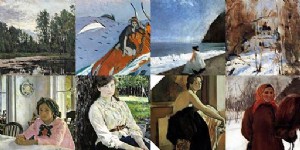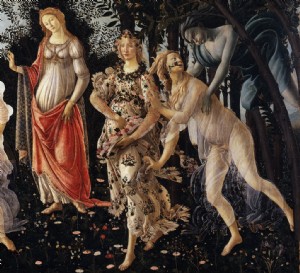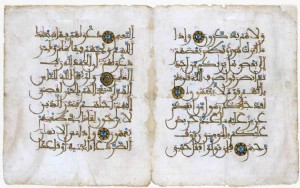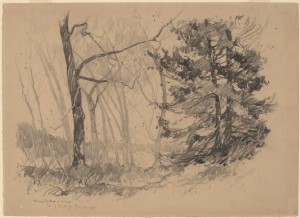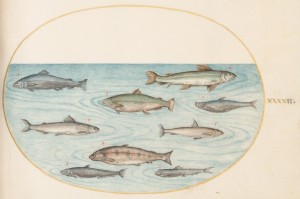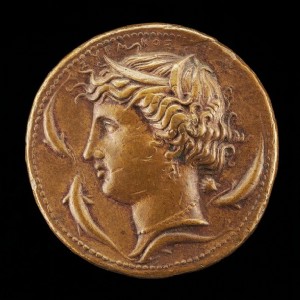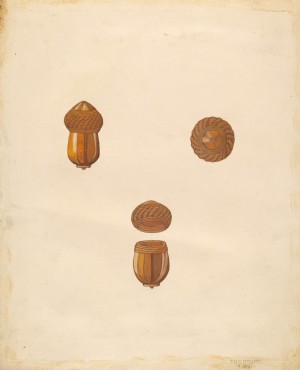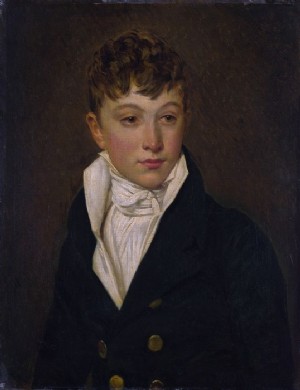Henri Russo (1844-1910)
Como muchos genios que se adelantaron a su era, Henri Rousseau no supo durante su vida, ni fama ni riqueza. Un artista talentoso, que trabajó hasta los 41 años como empleado ordinario en el departamento de aduanas de París, encontró la fuerza de voluntad para renunciar a su forma de vida habitual y dedicarse por completo a la pintura. Lo único que apoyó a Rousseau en su hobby fue una fe inquebrantable en su propio talento, lo que le permitió convertirse en uno de los más grandes maestros de su época. Asombrosamente, el deseo de imitar las técnicas del pasado transfirió al artista directamente al futuro:su forma creativa se convertirá en muy característica de muchos maestros del siglo XX. El arte "ingenuo" de Russo, siguiendo el ritmo del impresionismo, pronto se separó en una escuela completamente diferente. El estilo original del pintor, repleto de elementos de fantasmagoría, fue admirado por Pablo Picasso y Robert Delaunay, dándole al propio Rousseau sólo un mínimo de medios de subsistencia durante su vida.
Juventud tormentosa
Comenzando su carrera como artista a la edad de cuarenta y un años, Henri Russo fue autodidacta. Llegando de las provincias de París y asentado como un pequeño funcionario, Rousseau pintó en todas partes:mientras estaba de servicio en el trabajo, aprovechando el favor de sus superiores, y por la noche en casa. Pobre, pero paciente modesto, pero confiado en su genio, se convirtió en uno de los principales y más reconocidos maestros de las vanguardias artísticas, que fue admirada por contemporáneos progresistas y generaciones de descendientes.
Una vez que el propio Rousseau escribió una nota autobiográfica para el libro "Retratos del próximo siglo":"Nacido en Laval en 1844 en una familia con ingresos modestos y desesperados, se vio obligado a dedicarse a la profesión equivocada, lo que lo atrajo a su amor por el arte ". Cierto, el libro nunca salió.
El padre de un artista autodidacta fue Julien Russo, un hojalatero hereditario de una ciudad del oeste de Francia, Laval. Y su madre es hija de un oficial del Gran Ejército de Napoleón. El padre de Henri quería desesperadamente hacerse rico, por lo tanto, habiendo comprado una casa en las afueras de la ciudad, deja su oficio como hojalatero y trata de establecer un negocio de reventa de diversos productos. Pero, Pobre de mí, su trabajo está quemado, y desde entonces la pobreza desesperada se ha asentado en la casa de Russo.
Afortunadamente, a pesar de la extrema necesidad, la familia de la futura artista pudo enviar a su único hijo a estudiar primero en la escuela, y luego en el Liceo. Henri era un estudiante promedio, aunque logró obtener varios premios escolares, distinguiéndose en el canto y la aritmética. Estos logros aparentemente insignificantes se mencionan en todas partes en su biografía, no porque Rousseau se convirtiera en artistas de fama mundial, sino porque también escribió un vals increíble que lleva el nombre de su primera esposa:“Clemence”.
Después de entrenar, Henry acepta un trabajo en la oficina de abogados, donde comete un gran error. A la edad de diecinueve años instigado por sus amigos, Rousseau roba una pequeña cantidad de dinero del departamento de contabilidad, pero esto es suficiente para poner fin a su carrera de abogado y ser investigado. En la corte, Henry tiene que llegar a un acuerdo:hasta siete años de servicio militar, por solo un año en prisión.
El regimiento Russo, estacionado en Francia, nunca participará en hostilidades en el extranjero. Incluso cuando Napoleón III envía el cuerpo militar francés a México para apoyar a su protegido Maximiliano en la lucha por el trono imperial, la futura vanguardia no participa en la expedición. A pesar de que, mucho más tarde, el poeta Guillaume Apollinaire (1880-1918) escribe un poema sobre la estancia de Rousseau en el colorido país azteca, el artista nunca intenta refutarlo, así como una serie de otros mitos sobre su vida.
En 1868, muere el padre de Rousseau, y Henry, como único sostén de la familia, Recibe la destitución del ejército. Habiendo dejado su regimiento, que entonces estaba ubicada en París, se sumerge de lleno en la ajetreada vida de la gran ciudad. En primer lugar, el joven encuentra trabajo y se quita la vida, ubicado no lejos de Le Bon Marche, el primer centro comercial de varias plantas de la capital francesa.
El joven se enamora inmediatamente de la hija de la dueña de la casa, Madame Buatar. En 1869, toma a Clemence Buatar por esposa. A pesar de la constante debilidad (Clemence estaba enfermo de tuberculosis), el cónyuge ayuda a Henri a ganar dinero de por vida, incansablemente cosiendo por encargo. En los fines de semana, los amantes a menudo caminan por los hermosos parques parisinos. Cierto, la felicidad de Henri y Clemence se ve ensombrecida por el hecho de que sus hijos mueren uno tras otro en la infancia.
De los siete hijos de esposos amorosos, sólo dos sobreviven:la hija de Julie-Clemence y el hijo de Henri-Anatole. La esposa de Russo, constantemente atormentado por la tuberculosis, estaba demasiado débil para cuidar de los niños ella misma, así que desde que nacieron fueron criados por una niñera que vivía en un suburbio de París. En 1888, Clemence muere. Henri Russo nunca olvidará a su amada esposa. Incluso durante su vida, le dedicaría un vals de su propia composición, y después de su muerte, él volverá a crear sus retratos una y otra vez.
Pequeño arte oficial vivo
En 1871, el joven Russo consiguió un trabajo fijo en la aduana del Departamento de Impuestos Especiales, que en el siglo XIX recaudaba impuestos sobre los bienes importados a París. La inspección de mercancías en las puertas de la ciudad es una ocupación aburrida y monótona, pero no limita la libertad interior de la persona que lo realiza.
Durante uno de los siguientes turnos, un pequeño empleado instala un caballete en el patio del edificio del departamento, y comienza a dibujar. Desafortunadamente, las pinturas pintadas por Russo hasta 1877 no sobrevivieron. La excepción es solo una, que representa una escena de batalla con el telón de fondo del paisaje local.
Pronto, el entonces famoso artista Felix Clement (1826-1888), que ayudó al joven Russo con consejos, presenta al aspirante a pintor a uno de los representantes del arte oficial francés de esa época, Barón Leon Jerome. Después, Rousseau alquiló su primer taller y en 1885, apoyado por el barón, Expuso por primera vez dos de sus obras en el Salón de los Miserables.
Un año después, en 1886, el artista Paul Signac (1863-1935), interesado en la obra de Henri Russo, lo invita a participar en una nueva exposición. Signac consideró que el mejor lugar para las obras de un pintor tan original era el Salón de Artistas Independientes, creado por representantes del arte de vanguardia. El hecho es que todos los primeros intentos de crear salones independientes terminaron en fracaso, como por arte de magia, empezaron a parecerse al Salón oficial, lo que no se adaptaba a los pintores progresistas que sentían una creciente necesidad de exhibirse por separado.
Para Rousseau, Era obvio que los círculos artísticos oficiales representados por el Salón, con su vieja tradición académica, hubiera rechazado para siempre al autodidacta, al menos desde el principio. Por lo tanto, desde ese momento hasta el final, Henri Russo se mantendrá fiel al nuevo "salón sin jurado".
Ya en 1886, habiendo expuesto cuatro de sus obras en un salón independiente, el aspirante a artista será muy apreciado por pintores famosos como Paul Gauguin (1848-1903) y Puvi de Chavannes (1824-1898), que estaban encantados con la capacidad de Rousseau para transmitir momentos dramáticos con la ayuda de muchos tonos de negro. Pero, en general, sus obras siguen siendo incomprensibles para el público, más aún, son ridiculizados, los académicos afirmaron que incluso un niño es capaz de dibujar así.
Afortunadamente, Rousseau fue muy resistente al sarcasmo y la crítica del público. Incluso llega a un acuerdo con Argus, según el cual se le enviaron todos los artículos de revistas y recortes de periódicos, que contenía reseñas y comentarios sobre su trabajo. Anticipándose al reconocimiento universal de su indiscutible talento, el artista los pegó pedante en un cuaderno, que eventualmente se volvió más grueso. Es por los periódicos que Russo se entera una vez de que el Ayuntamiento de París le otorgó una medalla. Contento, inmediatamente ordena mencionar el premio en su tarjeta de presentación, pero luego resulta que tenía prisa:se trataba de otro artista con el mismo nombre.
Preocupado por la muerte de su esposa por encontrar fondos para el mantenimiento normal de los niños y comprar pinturas, Rousseau, con la esperanza de ganar dinero y quedar impresionado por la Exposición Mundial en París en 1889, en el que Francia presentó su famosa Torre Eiffel, el artista vuelve a la música y escribe el libreto para vodevil. Desafortunadamente, no trajo ni un centavo.
Después de retirarse del servicio en 1893, después de años de servicio, Rousseau recibe una pensión exigua y solo puede soñar con el momento en que su pasatiempo favorito:la pintura, finalmente comenzará a generar ingresos decentes. Mientras tanto, Russo se ve obligado a dar lecciones de violín y dibujar pinturas por encargo, vendiéndolos a precios ridículos. A pesar de que, solo un año después, su obra "La Guerra", exhibido en el Salón de los Independientes, obtiene una amplia respuesta, en particular, el escritor Alfred Jary (1873-1907) la admira, con cuya luz, el artista Henri Russo recibe el sobrenombre de "oficial de aduanas" (Le Douanier), fijado a él de por vida.
Pronto, toda la familia Russo se muda, quien es donde. En 1895, la hija de la artista se va con su marido a Angers, ubicado en el oeste de Francia, y el pintor se muda con su hijo Henri-Anatole a vivir en Montparnasse, la famosa zona de la orilla izquierda del Sena, que luego se convirtió en lugar de encuentro predilecto de las vanguardias artísticas e intelectuales. Allí, en Montparnasse, Rousseau conoce a Josephine Le Tensorer, una mujer que vivía en el barrio y que se ganó el corazón del artista. Por mucho tiempo, Josephine descuidó las confesiones de amor del pintor y aceptó convertirse en su esposa solo después de la prematura muerte de Henri Anatole.
Como francmasón amante de la libertad, Henri Russo todavía se casaba en la iglesia con su nuevo amor en 1898. La situación financiera de la familia era bastante deplorable. por lo tanto, para ayudar a su marido, Josephine intentó vender su trabajo en su tienda de suministros de oficina, y el artista, Sucesivamente, continuó dando lecciones pagadas. Sin embargo, los domingos, Rousseau, a pesar de su necesidad, en el marco de la Philotechnical Society, cuyo principal objetivo era educar a las masas, enseñó a todos los que querían pintar en acuarela, pastel, y también, con orgullo y placer, compartió su experiencia en la pintura de porcelana y cerámica.
Mendigo genio
Solo cinco años después, en 1903, el pintor queda viudo por segunda vez, y, tratando de hacer frente al dolor, se dedica por completo al trabajo. Debo decir, su carrera como artista, finalmente comenzó a ganar impulso rápidamente. En 1903, participó nuevamente en dos salones de arte:Artistas Independientes (en marzo) y en el primer Salón de Otoño, que abrió en octubre. Pero el pintor todavía tiene una gran necesidad. Afortunadamente, la modesta pero generosa familia papú, que vivía en el barrio, a menudo lo invitaba a cenar, y amiga Marie Bisch, que se dedica al comercio a pequeña escala, más de una vez ayuda a Russo en situaciones financieras críticas.
El punto de inflexión ocurre solo en 1906, cuando el artista conoce a Robert Delaunay (1885 - 1941) y al poeta Guillaume Apollinaire. Los nuevos amigos admiran abiertamente el talento del pintor, y Pablo Picasso (1881-1973), habiendo adquirido accidentalmente el Retrato de una mujer de Bris Henri Russo en 1908, organiza un magnífico banquete en honor al autor.
Uno de los amigos de Picasso, Fernanda Olivier, describe Rousseau:"Este respetable, un hombre ligeramente encorvado que tiene más probabilidades de trotar que de caminar, su cabello es gris pero espeso, a pesar de su edad, tiene los hábitos de un pequeño rentista, y su rostro está un poco asustado, pero amable. Se sonrojaba fácilmente cuando se sentía avergonzado o cuando alguien se oponía a él. Él asintió a todo lo que se le dijo, pero se sintió que se mantenía apartado y simplemente no se atrevía a expresar sus pensamientos. "
Entre los amigos de Rousseau estaba Alfred Jary (1873-1907), el artista lo conoció en el momento en que la última obra - "King Ubu" (1896), que lo convirtió en el famoso fundador del teatro del absurdo, aún no estaba escrito. Quizás sea precisamente la pasión por lo impactante y la provocación lo que une a Rousseau y Jary. Según el joven escritor, el ingenuo arte del aduanero, franco e intransigente, impactando al hombre promedio. Una vez, Zhari encargó al pintor su retrato. La imagen, Desafortunadamente, no ha llegado a nuestros días, pero se sabe que Russo retrató a su amigo con un camaleón y un búho. ¡Fry estaba encantado! Le paga a Rousseau dinero de la herencia paterna y en todas partes ensalza su talento. El artista apreciaba esta amistad. Fue él quien extendió una mano amiga y protegió al joven excéntrico cuando la suerte lo cambió en 1897. y Zhary, sin un centavo en su bolsillo, Terminó en la calle.
Henri Rousseau tenía un claro, voz infantil, todos lo consideraban ingenuo y sencillo, pero ¿fue realmente así? La confianza inquebrantable en su propio genio permitió al pintor convertirse en una persona decidida con una resistencia extraordinaria. y una ingenuidad casi infantil, un artista muy original.
En diciembre de 1907, Rousseau, por su descuido y credulidad, nuevamente fue a la cárcel por fraude, a pesar de que, De hecho, él fue su víctima. Para conseguir la libertad aunque solo sea para dar lecciones benéficas los domingos, el artista escribe una petición a la Corte:“Volviendo a su amabilidad, Pido al menos libertad condicional para poder seguir trabajando. Te ruego que no destruyas mi carrera, por lo que trabajé tan duro. " Afortunadamente, La solicitud de Rousseau fue concedida después de las vacaciones de Navidad.
Trucos amistosos
Según los contemporáneos, Rousseau solía trabajar con una sencilla camisa blanca de lino, pero siempre se viste de traje cuando organiza recepciones en su taller. El coleccionista alemán Wilhelm Ugde, el primero en dedicar un libro completo al artista en 1911, era uno de los habituales de las fiestas de Aduanas. Así es como describió la calle donde estaba ubicada la casa de Rousseau:“Tiene solo unos pocos pasos de largo y luego descansa contra un muro de piedra. Parece que estamos en algún lugar de la provincia y no en París. En las habitaciones de la planta baja el propietario vive con su familia, y arriba están los apartamentos de los invitados. En una de las puertas hay un cartel:"Lecciones de retórica, música, dibujo, solfeo ”. Llamamos y entramos:Russo nos recibe. "
Casi todos los sábados por la noche entre sus cuadros y amigos, el oficial de aduanas toca el violín para los artistas, coleccionistas y amantes del arte. El esta enamorado de nuevo pero Leonia, una viuda de 59 años, se niega a convertirse en su esposa. En estas noches uno podía encontrarse a menudo con el dueño de la casa donde vivía Rousseau:el Sr.Keval, un hombre tranquilo y respetable que era compañero de trabajo de Russo en el departamento de aduanas de París. Entre los invitados a menudo era posible ver a Ambroise Vollard, quien compró cuadros del artista y lo invitó con él más de una vez a fiestas artísticas. Henri Rousseau estaba en un arrebato emocional:finalmente llegó el momento de probar los frutos de muchos años de arduo trabajo:una situación financiera estable, reconocimiento universal. Eso es solo salud ... El pintor ha estado preocupado durante mucho tiempo por las heridas sin cicatrizar en sus piernas, cuales, en el final, causó gangrena.
Un artista brillante, Henri Russo murió el 2 de septiembre 1910 en el Hospital Municipal Necker de París. Fue enterrado en una fosa común. Robert Delaunay, Ambroise Vollard y Paul Signac vinieron a ver al artista en su último viaje.
Un año después, Delaunay organiza a sus propias expensas un entierro de los restos del artista. Y Guillaume Apollinaire escribirá en su lápida un epitafio compuesto por él:“Adiós, nuestro buen amigo Russo! Escúchanos - Delaunay con su esposa, Keval y yo. Te traemos pinceles, pinturas y lienzo como regalo, para que pintes retratos de estrellas en tu santo ocio. "
Trabajo temprano
Mirando las primeras pinturas de Henri Russo, uno de los críticos exclamará:"Es sincero e ingenuo, algo que recuerda a los primitivos ". El segundo crítico está de acuerdo:" Esta pintura es bastante seca y dura, pero muy interesante, porque su ingenuidad conduce a la idea de primitivistas italianos ". Incluso los burlones y los ardientes oponentes de la obra original de Rousseau reconocieron al maestro como un primitivista sobresaliente.
Aunque los lienzos son "Caminando por el bosque" y "Encuentro en el bosque", el pintor está aún más cerca de la pintura nacional de la época rococó del siglo XVIII que de los primitivos italianos. Esto se debe en gran parte al motivo tradicional claramente visible de escenas galantes (fiestas galantes), muy característico del artista francés Antoine Watteau (1684-1721), cuyas pinturas se exhibieron en el Louvre. Por cierto, fueron sus reproducciones las que adornaron las paredes del taller Russo.
Las obras del período temprano en Rousseau lo distinguieron mucho de sus contemporáneos, los impresionistas. Esto se puede ver claramente en el sofisticado esquema de color de las pinturas "Encuentro en el bosque" y "Paseo en el bosque", en el que el pintor representa árboles reales e imaginarios utilizando una gran cantidad de diferentes tonos de marrón y verde.
En la primera imagen, el bosque es denso e intransitable, en el segundo - ligero y transparente. Todos los planes a largo plazo están hechos por vagos, pequeños trazos, que facilita la percepción visual, neutralizando un bosque oscuro demasiado saturado. ocupando un tercio de la imagen, árboles deliberadamente reducidos en la distancia - todo esto habla del intento del artista - autodidacta de determinar de alguna manera los límites del espacio, dale profundidad, es decir, para mostrar la perspectiva de que para Rousseau, privados de conocimientos y habilidades académicas, fue un verdadero obstáculo. Quizás por eso más tarde abandonó deliberadamente cualquier perspectiva en sus lienzos.
La pintura "Encuentro en el bosque" muestra a los amantes montando a caballo y mirándose el uno al otro. Están vestidos con trajes típicos del siglo XVIII. El cabello largo de la mujer está suelto sobre sus hombros, un motivo que está presente en muchas imágenes femeninas del pincel de Rousseau. La fuerza de los sentimientos abrazos mutuos, La ternura en la mirada del hombre crea un claro efecto de la presencia de esta pareja en el lienzo, a pesar de que sus cuerpos son prácticamente invisibles detrás de la exuberante vegetación. Amar solo en su propio mundo, aparecieron por un corto tiempo desde detrás del bosque, y parecía que estaban a punto de desaparecer de la vista para siempre otra vez.
En el lienzo "Caminando por el bosque" vemos a una mujer muy parecida a Clemence, parecía congelarse, tal vez estaba asustada por los ecos precipitados de la cabalgata, el susurro alarmante de las hojas o el crujido repentino de una rama.
Imágenes de mujeres
Imágenes femeninas, así como imágenes de animales, ocupó un lugar enorme en la obra del artista. Dos grandes retratos femeninos, pintado por Rousseau con un pequeño hueco, son composiciones muy similares. Ambos representan a mujeres vestidas de negro de pie de cuerpo entero. El formato de las obras y las poses de los personajes permiten atribuir las pinturas al género de los retratos de desfile. Quizás ambos se hicieron por encargo, aunque se desconoce la identidad de los modelos.
El primer lienzo - "Retrato de una mujer" (nombre alternativo "Retrato de la señora M.") fue creado alrededor de 1895. Fue este cuadro que fue adquirido a un precio muy modesto en 1908 por otro artista brillante - Pablo Picasso (1881 -1973), quien estaba muy entusiasmado con eso. Este trabajo también se conoce como Jadwiga, aunque no hay evidencia de que el nombre del modelo coincida.
Hay una leyenda según la cual la niña del lienzo era una bella mujer polaca que encantó al pintor. Y aunque esta versión no tiene evidencia, el hecho es que a Rousseau le gustaba este nombre. Él mismo los llamó el personaje principal de la obra de su propia composición:"La venganza del huérfano ruso". Quizás fue ella quien encarnó para el artista cierta imagen de la mujer ideal. Por el mismo nombre, el maestro llamará a la heroína de su otro lienzo - "Sueño" (1910).
La composición del primer retrato se asemeja a una fotografía montada de una tienda en ese momento. Una figura femenina se encuentra en un balcón lleno de floreros contra una enorme cortina, rodeado de un paisaje fantástico. En manos de Jadwiga hay una rama de árbol. Este detalle es de particular interés por ser un símbolo tradicional de la muerte. Esto se puede explicar, si crees a los partidarios de la teoría de la existencia real de esta mujer, quienes afirman que en el momento de escribir el lienzo Jadwiga ya estaba muerta. Esta suposición se confirma indirectamente por el hecho de que el artista eligió el color negro para el vestido de la mujer, que siempre enfatizó la naturaleza dramática especial de la escena representada.
La mujer del segundo retrato está representada en medio de una emocionante variedad de vegetación. Su mano descansa sobre su muslo, y sus piernas asomando por debajo de su vestido apenas tocan el suelo, que crea la ilusión de movimiento. En la parte inferior del lienzo vemos un gatito jugando con una bola de hilo, aportando vivacidad y espontaneidad al tono oficial del retrato.
Russo termina su famosa obra "El gitano durmiente", también dedicado a la imagen femenina, apenas un mes después de la muerte de su único hijo, Henri Anatole.
En 1897, expuso la obra en el Salón de los Independientes, acompañándolo con una leyenda escrita en el marco:"Un depredador, abrumado por la sed de sangre, se congela en su lugar, sin atreverse a atacar a una víctima profundamente dormida ". La figura de la gitana con su bufanda y ropa colorida, en marcado contraste con la tez oscura, recuerda un poco a las mujeres orientales de las pinturas de artistas académicos. Fue esta obra la que propuso activamente Russo para adquirir las medidas de su ciudad natal de Laval, en memoria de sí mismo.
El artista incluso escribió al alcalde de la ciudad:"Aquí todo está bañado por la luz de la luna". Por supuesto, el ayuntamiento rechazó su oferta. La obra desaparece y es redescubierta recién en 1923 y, dado que no todas las pinturas de Rousseau eran ampliamente conocidas, provoca mucha polémica y rumores. Muchos lo consideran falso, una broma, que se atribuyó a otro artista:Derain. Aquellos que no dudaron de la verdadera autoría del cuadro, lo consideró como un paso muy decisivo del pintor del realismo al surrealismo.
Pronto, Rousseau se apartó de los impresionistas, aunque todavía compartía su disgusto por los cánones tradicionales de las bellas artes. El impresionismo implicaba la libertad creativa tan necesaria para Rousseau. Su arte, basado en una interpretación completamente plana de todas las formas, no solo no tiene en cuenta las reglas estándar para representar perspectivas adoptadas en el Renacimiento, pero también las descuida conscientemente. El artista simplifica la forma, creando su propio estilo de pintura único. Las proporciones reales están distorsionadas aquí, la elaboración de color del volumen está ausente, y la sombra no existe en absoluto. Rousseau did not want to portray boring and mundane reality, passing through his rich imagination all images and forms.
The artist’s art strongly resembles decorative painted pictures with multi-colored figures of smooth texture and unpretentious shape. His painting "The Child with the Puppet" makes a strange impression that makes one shudder. The master first delineates the contours of the figure of a child resembling a porcelain doll, leaving it itself unwritten, then works on the background of the picture and returns to the figure again. Rousseau, like Emil Bernard (1868 - 1941) and Paul Gauguin, completely ignores the principles of classical perspective. Además, the painter gives a clear preference to substantive conventions, rather than boring specifics.
Children’s portraits
Brushes Russo own many children’s portraits. It is not known why the theme of children was so important for the artist, if they were custom-made works, if the artist felt the loss of his six children. The exact answer to this question is unknown, we can only assume that, portraying children, the painter tried with the help of paints, brushes and imagination to bring back to life the images of his loved ones. Many of Rousseau’s portraits of children are in large format.
Por ejemplo, a child in a red dress looks so large that it feels as if his figure hardly fits on the canvas. Aparentemente, the child is sitting:legs bent at the knees and almost hidden in the grass speak about this. The figure itself seemed to hover between heaven and earth, which imperceptibly smoothes the feeling of excessive massiveness. Like “The Child with the Puppet, ” the kid in this picture also holds a strange doll in his hand, resembling an adult with facial features.
In another picture of the same period - “Peasant Wedding”, we see a bride who looks at us with humble reverence. The figures of the people around her are so flat that they seem to be separately cut out of colored paper and glued to the background landscape. Even in spite of the trees carefully arranged by the letter “V” and some awkward dog located in the foreground, which theoretically should have been a compositional designation of the perspective, they could not erase the collage impression made by this painting.
The bride’s figure is the undisputed dominant of the picture, it is she who, with her snow-white belt, seems to connect the remaining characters into a single group. On the canvas, the artist symbolically indicated the continuity of generations, with the help of a long veil of the bride, slightly covering the elderly woman sitting nearby, who is obviously the grandmother of the bride or groom. The figure of an old man sitting separately from the group of main characters, whose legs are hidden in the grass, conjures up thoughts about the connection between modernity and eternity, life and death, earth and sky. The solemnity with which the whole group is located under the trees again reminds of a 19th century shop. It was in such static poses that people froze in front of a photo lens against the background of painted flat scenery:“We don’t move! Do not breathe! ". It’s possible that while working on the “Wedding”, the painter drew inspiration from some photograph, but nothing is known about the reasons for his appeal to this topic, as well as about the personalities of the prototypes of the characters. Although the man standing to the right of the bride remotely resembles the artist himself.
Symbolic works
In 1906, Henri Rousseau presented to the public his new work - “Freedom, calling for painters to participate in the 22nd exhibition of Independent Artists”, which, even being in the exhibition of the Salon of Independents, causes visitors to laugh only. Only a close circle of friends admires the new work of the artist, while the rest can not understand either the design itself or the ways of its implementation.
Friend of the painter - Robber Delaunay exclaims:“In another era, he would have painted the walls of the palaces by order of patrons. In ours, he is forced to be a jester for the inhabitants, he is so serious, so calm. What a senseless irony of fate! ” Russo celebrates the Salon with his new work, which made him a full-fledged artist, en todo el sentido de la palabra. The compositional center of work is the allegorical figure of Liberty, depicted in a manner reminiscent of the academic. She plays the trumpet, traditionally a symbol of worship.
Un año después, Rousseau again amuses the audience in the Salon of Independents with his work “Foreign representatives arrived under the banner of peace to salute the Republic”. On the canvas, we recognize the six presidents of the French Republic (dressed in black) standing on the podium, the Russian emperor (in a yellow and blue uniform), the king of England (on the left side), and also on the right:Franz Joseph from Austria, Peter I from Serbia, William II from Germany, Leopold II from Belgium, George I from Greece, the Persian Shah and King of Ethiopia. The republic, in red robes and a Phrygian cap (the headdress of the era of the French Revolution of 1789) triumphantly rises above all, holding an olive branch in outstretched hand. This multicolored extravaganza, colored by foreign flags, passes under the slogan written on three black pedestals standing in the foreground of the canvas:“Work, freedom, equality. ” And in the background we see people gathering in a circle to start their holiday dance.
The artist was very fond of allegories, so popular among representatives of political circles. Repeatedly Rousseau took part in various competitions, which from time to time are arranged by the Paris authorities in order to decorate the premises of various departments. The painter always wanted to receive an official order, well paid and prestigious, porque, firstly, he constantly felt the need for money, y, en segundo lugar, he still dreamed of universal recognition.
Sin embargo, the Customs Officer has failed to conquer either one or the other. Además, all the time there were people who used this artist’s weakness and his inherent naivety to repeatedly play poor Rousseau. It even came to the point that the painter almost went to the Champs Elysees to personally thank the President of the French Republic for awarding him with his main state award - the Order of the Legion of Honor, the award of which was announced to the artist by evil jokers.
Exotic India
Una vez, the mother of the artist Robert Delaunay, succumbing to the entreaties of her son, decided to order a Russo painting. Her stories about an exotic trip to India inspired the Customs Officer to create a canvas designed in rich green tones typical of the tropical jungle. In the center of the picture we see the figure of a black-haired woman - a snake charmer, who is very reminiscent of an ancient mystical deity. Black snakes, as if mesmerized by the magical sounds of her pipes, slowly creep out from everywhere, and if at first glance they are barely distinguishable, then when the look gets used to a variegated variety and begins to distinguish details, you see them more and more. Amazingly, their movement on the canvas is felt almost physically. The eyes of the female figure, which are the only bright spot in the picture, add a mystical shade to the canvas, their tremendous attractive power is striking.
A river illuminated by a full moon, a thick and mysterious veil of plants shimmering in all shades of green, an exotic pink bird, brightly shining yellow flowers - the whole scene exudes incredible paradise and tranquility. The vertical lines of the figure and the plants surrounding it are softened by horizontal rays of light coming from the month. This fundamentally distinguishes the composition of “The Enchantress” of Rousseau from his “War”, where the horizontal construction of the entire canvas creates the effect of decay and symbolizes destruction and destruction.
Unpleasant Surprise is somewhat close to Snake Charmer. In this picture we see a woman scared by a bear. The figure of the woman again resembles the mythical goddess, or Old Testament Eve, lost in the Garden of Eden. Her round hips are slightly covered by hair falling down to her knees. As in The Caster, the woman is surrounded by the same bizarre trees with bright foliage, and in the background - on the shores of a magical lake, depicting dense forests of bizarre trees. And in the depths, the figure of a lurking hunter is hardly noticeable. When you see her, the soul becomes calm - he will certainly shoot and save the woman from the predator.
Contemporaries will write down a statement by an Italian critic dedicated to Rousseau:“He lives in a strange world, fantastic and real at the same time, close and far, sometimes funny, sometimes tragic. He loves a riot of colors, fruits and flowers, wild animals and fabulous birds. He lives, working unconscious, focused and patient, met with ridicule and unfriendly shouts every time he decides to break his loneliness in order to present his creation to the world. "
Buddy portrait
The hero of the picture “Chaise of Father Juniet” (1908) is a real character - a seller of vegetables, a former friend of Rousseau (though his real name was Claude Junier). His shop on Montparnasse was located just a few meters from the painter’s workshop. Junier always helped an artist who often lacks money for products. Sometimes Junier, along with his friends, took Rousseau to ride on his chaise, which served him for the transport of goods. Juniera’s pet - a mare Rosa pulled a chaise. The seller of vegetables had a great weakness for horses and dogs, one of which is shown in the picture next to the chaise.
When creating the canvas, the artist used a photograph taken in Klamar in 1908. Rousseau transferred the composition of the photograph to the canvas, adding to it a dog on the road and several figures. While the painter was working on the painting, his workshop was visited by the American artist Max Weber (1881-1961). Considering the work, Weber drew the author’s attention to the imbalance in size between dogs and other objects and characters. Rousseau replied:"Everything must remain as it is."
Perhaps the artist is right, relying only on his own vision, because when you look at this work for a long time, it starts to seem that it is this absolutely disproportionate, and therefore some mysterious dog that gives the picture a touch of fabulousness. It is the altered proportions and disturbed perspective, abundantly supplemented by elements of phantasmagoria, that give Rousseau’s everyday scenes this element of attractiveness and mystery.
Five people and a dog are sitting in a chaise. All of them are depicted facing the viewer, as if lined up in a line, like a group from the canvas "Peasant Wedding", but at a clear angle with respect to the seats of the chaise and the direction of the road. The canvas has an impressive size, very characteristic of works of decorative art, and this, according to critics, makes it similar to the "tapestries of a thousand flowers" - magnificent carpets popular in the 15th century on which colorful ornaments were woven from fancy plants.
Por primera vez, the artist uses an absolutely smooth canvas in the painting, thanks to which the strokes are almost invisible. The whole color of the picture is clearly divided into two scales:black, white and red in the foreground, and ocher, green and blue - on the "backdrop".
City landscapes
Less well-known but no less significant part of Rousseau’s creative heritage is urban landscapes. Numerous types of Paris and its suburbs were in high commercial demand, por lo tanto, the artist, constantly constrained by the means, had to write them tirelessly. In those distant times, the outskirts of Paris were still little built up and literally buried in the pristine greenery of forests. The artist did sketches for future paintings immediately with oil paints, without using gouache or charcoal. He confidently writes from life, directly on canvas, only sketching from time to time.
Prescribing individual fragments in the open air with sweeping sharp movements of the brush, Rousseau completes the picture already in the workshop, carefully finalizing the details of each component. Two of the most famous examples of urban landscape in the work of Rousseau are the canvases “Furniture Factory in Alfortville” and “View from the Sevri Bridge”. On them, the painter depicted a free interpretation of the factory for the production of armchairs and chairs in Alfortville and one of the districts of Sevri on the southwestern outskirts of the French capital.
The Furniture Factory in Alfortwigle was written ten years earlier than The View from Sevri Bridge. When you look at the picture, the sky immediately catches your eye, with bizarre clouds on it. On the left is a river, and in the background is a bridge. But both elements are, bastante, of secondary importance. All the compositional construction of the painting comes from the wavy sidewalk, which unexpectedly creates the impression of the right perspective, rare for Russo’s paintings. The factory building itself strongly resembles a cardboard house from theatrical scenery, and figures of people around look unnatural. All this makes the scene very conditional, almost surreal.
A striking element of the picture is the figure of a fisherman in the foreground. Inicialmente, his image was only a compositional necessity. Sin embargo, after the character was completed, the artist discovered that this fisherman, waiting for the bite, symbolizes a certain existence outside of time and space, thus embodying eternity in the picture. It is this distinctive approach to the depiction of time that sharply distinguishes Rousseau from the Impressionists, who were characterized by admiring a moment taken separately from life.
The compositional center of the second picture is the bridge over the Seine, which connects its wooded shores. The black and white boat, located in the foreground, is very expressive, its hull is strangely similar to the face of a man. Small figures of pedestrians merge with houses shaded by red foliage. Red and gray-green roofs perfectly match the gamut of the autumn landscape. A balloon, a hang glider and an airplane symbolize the three epochs of conquering the sky, which were often mentioned in the press of that time, and which Rousseau himself admired.
Sueños
En 1910, Henri Russo creates his greatest masterpiece - the canvas "Dream", exhibited by him in the same year at the 26th Salon of Independents. All his friends and colleagues unanimously claim that the work is worthy of the best reviews. The poet Guillaume Apollinaire writes about her in one of his articles:“I think that this year no one dares to laugh. You can ask the artists - everyone is unanimous, everyone admires them, even this sofa in the style of Louis - Philippe, lost in a virgin forest. And they are right. "
Russo supplies the work with the following comments:“Jadwig has a magical dream. She quietly fell asleep to the flute of an unknown seducer. When a month casts light on flowers and green trees, animales and even predators, freeze, listening to the wonderful sounds of music. ” Andre Breton (1896 - 1966) will note, a few years later:“I am close to saying:this great canvas absorbed all the poetry and all the secrets of our time. It is characterized by the inexhaustible freshness of discoveries… "
The painting "Dream", which has become one of the last works of Russo, is considered the will of the artist. Intertwined, the plants create an illusion of space on the canvas, which is echoed by the whole color scheme of the picture. The feeling of depth is emphasized by iridescent shades of green. Monkeys frolic in bizarre branches, where bright exotic birds are seen everywhere, and below, under them, predators roam in the grass. Only a black musician stands in the thick grass and plays his flute, as if not noticing anything around. Both characters and plants are torn from real space, their characteristic form and their true condition, but they are all written out so carefully that they look incredibly plausible. As if anticipating his demise, Henri Russo leaves us a legacy of a true paradise.With his “Dream”, the artist illuminated the coming generation with the road to surreal art, ahead of his time.
In the same 1910, Rousseau painted another picture - “The attack of the jaguar on the horse”, bought later by the patron Ambroise Vollard. The artist himself was proud of the work. “Twenty-two shades of green!” - the painter proudly told the famous Italian critic Argendo Soffichchi, who came to him to look at a new work. Sofficchi was shocked by the picturesque manner of Rousseau. After drawing with a pencil all the contours of exotic plants, the artist applied various shades of green in separate strokes, prescribing each fragment several times, and carefully cleans the palette with each color change.
Among strangers
Despite the fact that Rousseau’s personal sympathies were always on the side of academic painting, he received recognition only among the most progressive contemporaries - avant-garde artists were his best friends all his life. The creative manner of the artist himself is attributed to primitivism, thanks to his original style and because of his love for Italian primitive artists, such as Fra Angelico (c. 1400 - 1455) and Giotto (1267 - 1337), who worked in the XIV and XV centuries, when the laws of a classical perspective had not yet been discovered, the absence of which would become a real hallmark of all of Rousseau’s work. “Only in 1885, after numerous disappointments, was I able to devote myself to art, studied myself, learned nature and took the advice of Jerome and Clement, ” says Henri Russo about himself.
In search of his own style, Russo worked a lot in the Louvre, creating copies of the masterpieces of the great masters of the past. The painter received permission to work in the famous museum thanks to his friend Felix Clement (1826 - 1888), OMS, like Rousseau himself, was a self-taught artist. Pero, unlike the Customs officer, Clement was recognized and kindly by the authorities. Él, the lucky winner of the Roman Grand Prix of the French Republic, was paid for accommodation and training in Italy. The intelligent Clement, a devoted friend and delicate adviser, never allowed himself to be ridiculed or mocked at Rousseau and his paintings. On the contrary, he always insisted that the artist remained faithful to his style and did not turn off the chosen road. Clement introduces the Customs Officer to Leon Jerome (1824 - 1904), who worked at that time on the artistic embodiment of the lofty scenes of ancient mythology and ancient Eastern plots. Jerome - the star of official art - belonged to a group of artists - pompiers, named for their pompous luxury inherent in their canvases and pretentious splendor, and for the characteristic headdresses of their ancient heroes, reminiscent of helmets of firefighters (pompiers).
With rare exceptions, such as Clement and Jerome, Russo’s friends belonged mainly to the circle of Independent Artists. It was the representatives of neo-impressionism, in particular Georges Cera (1859 - 1891) and Paul Signac (1863 - 1935), who were the first to recognize a brilliant and original master in Rousseau in 1886. Signac highly appreciated his talent as a colorist, and Camille Pissarro (1831-1903) was loudly admired by the artist’s works, recognizing that it was precisely “feelings in the first place”. Robert Delaunay, the former, together with his wife Sonia (1885 - 1979), one of the founders of abstract art, expressed their admiration for the artist.
Delaunay and Russo become friends, despite the fact that the Customs officer does not always penetrate the essence of the creative research of his friend. “Why did Robert break the Eiffel Tower?” - Rousseau’s sincere question regarding the painting by Delaunay led to the appearance of the legend about the Customs officer as a naive genius who never really understood the figurative techniques of avant-garde art.
The author of this, like many other legends about the artist’s life, was the modernist poet Guillaume Apollinaire. He created myths about Rousseau, passing through his poetic imagination the story of his life, and the artist, in turn, immortalized his image on canvas. Apollinaire described the process of writing his own portrait:“First of all, he measured my nose, boca, my ears, my forehead, my arms, my whole body and very accurately transferred all these measurements to his canvas, reducing it in accordance with the size of the frame. (…) I did not move, watching with admiration how anxious he was towards the work of his imagination, not allowing anyone and anyone to interfere in the creative process, so as not to disturb the harmony of the picture. And how mathematically accurately he depicted the figure of a man! If my portrait had nothing in common with my appearance, this would not have happened through the fault of Rousseau, but due to some annoying calculation error. Sin embargo, even those who are not familiar with me recognized me in the picture. ” In the role of the poet’s muse, the canvas depicts the artist and Apollinaire’s close friend, Marie Lorensen (1883 - 1956).
An evening in the history of art
Here is an example of one of the stories related to the life of Russo and his friends. One January evening in 1908, Rousseau and Apollinaire appeared in Bago Lavoir, where Pablo Picasso (1881 - 1973), an artist from Catalonia, set up his workshop in a small wooden house. The customs officer, wearing a soft felt hat, takes pride of place at the table, leaving outer clothing and a cane at the door. On the wall hangs the work of the self-taught artist "Portrait of Mrs. M." (that same mysterious "Jadwiga"). The wall itself is decorated with flags, lanterns and a large poster with the inscription "In honor of Rousseau." The guests present are all in high spirits, some have already visited the nearby tavern.
Apollinaire solemnly recites the ode he wrote for this evening:“We have gathered to honor you with wine, which pours Picasso. There is reason to drink, and we will drink and rejoice:“Long live Rousseau!” Around the table gathered:artists Georges Braque (1882 - 1963), Marie Lorensen and Andre Derain (1880 - 1954), writer Andre Salomon, poet Max Jacob (1876 - 1944) and two American women - the famous writer Gertrude Stein (1874 - 1946) and Alicia Toklas. Wine flows like water, Rousseau takes the violin and plays the waltz that he once wrote for Clemence. Then he comes to Picasso and quietly says in his ear:"We are the two greatest artists of the era." Then Apollinaire gets up again and reads a poem telling about Rousseau’s trip to Mexico invented by him:“Do you remember, Rousseau, the Aztec landscape? Forests where pineapples and mangoes grew, Merry monkeys, watermelon pulp, Race warmed the emperor Maximilian? "Your paintings come from Mexico, Where the burning sun and the riot of nature." An artist who has never been to this country does not even try to object, because today is the long-awaited day of his triumph.
Más tarde, a friend of Picasso, Fernanda Olivier will argue that the festive reception in Bateau Lavoir was a joke, a hoax. Sin embargo, Andre Salomon writes in his memoirs:"In Bato Lavoir, we had only one task - we wanted to give Rousseau the holiday he deserved." This technique in Bato Lavoir was one of the key moments in the history of the development of modern painting:it was there that two generations of artists met, thanks to whom new art was born.



